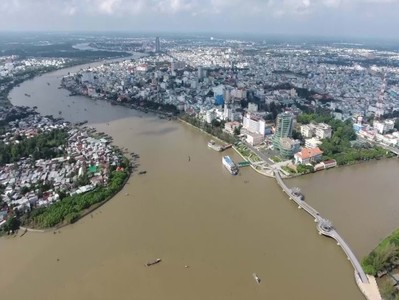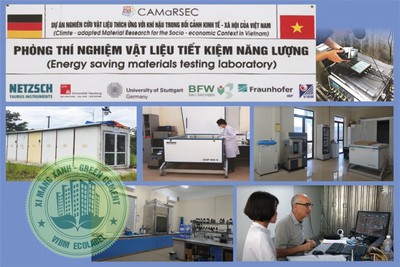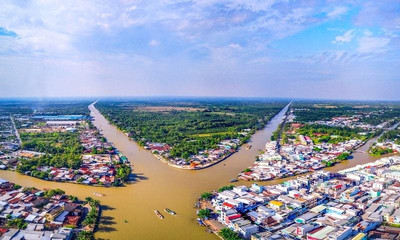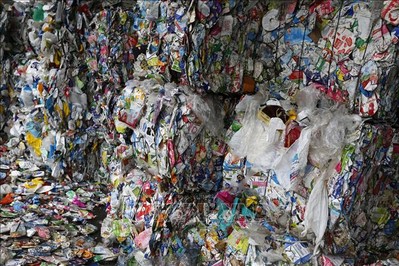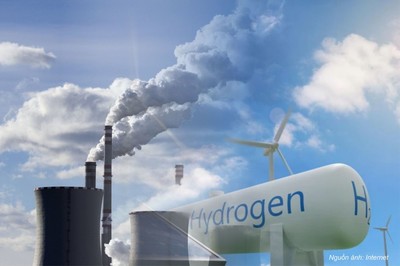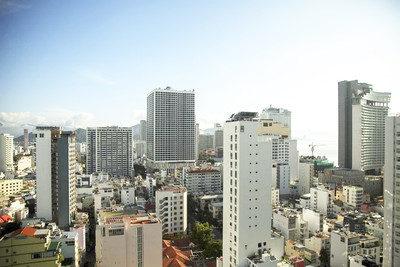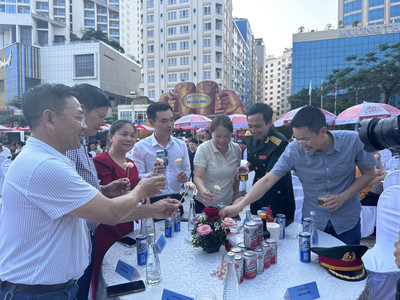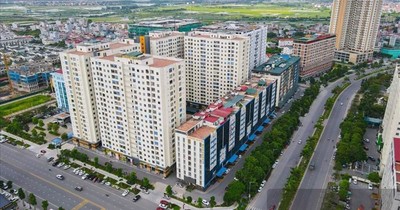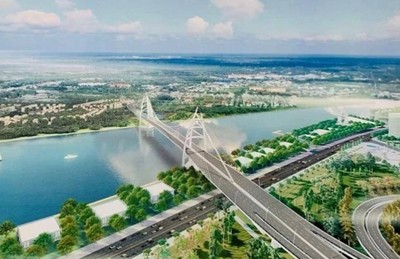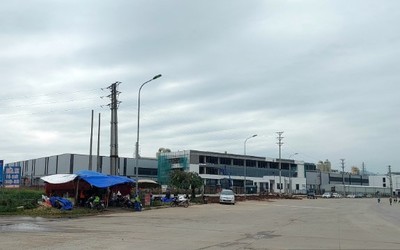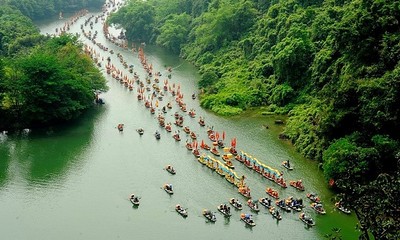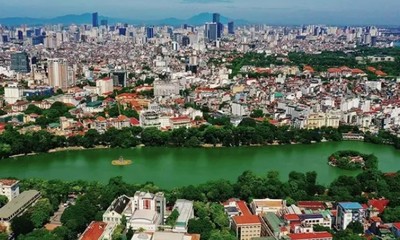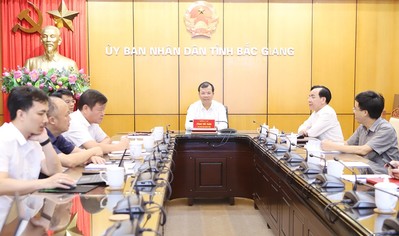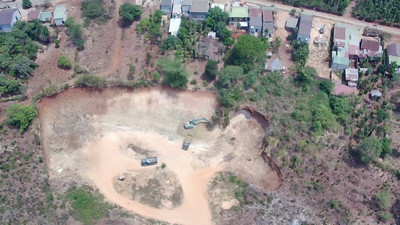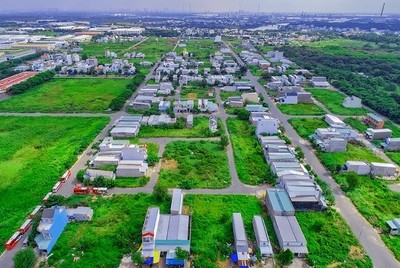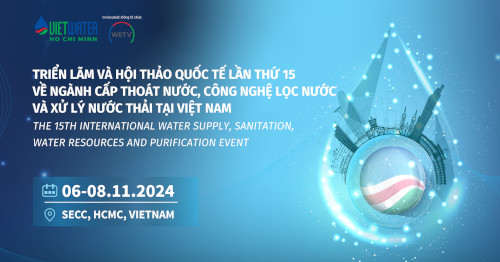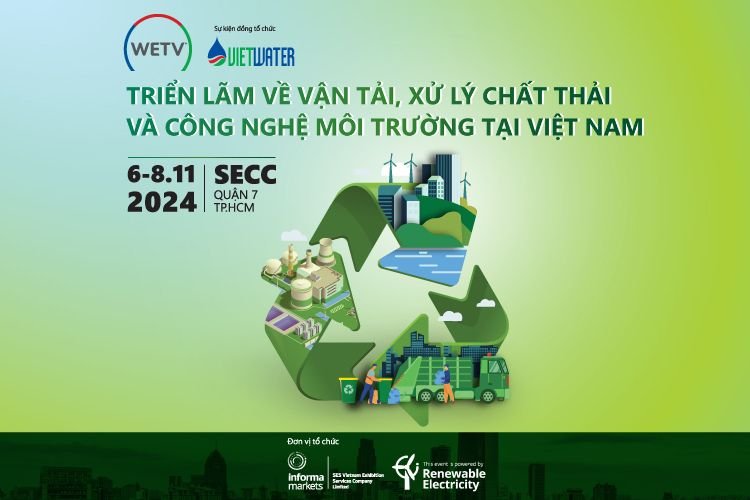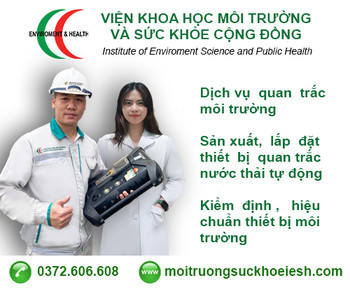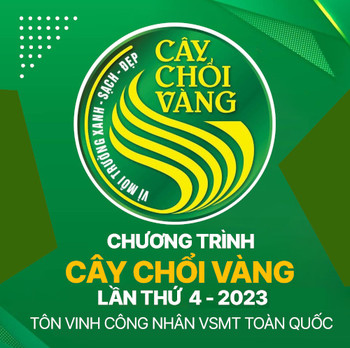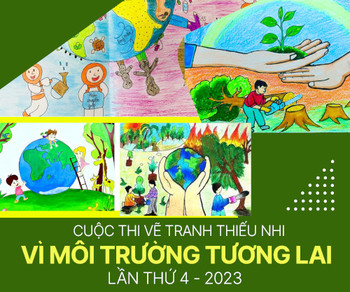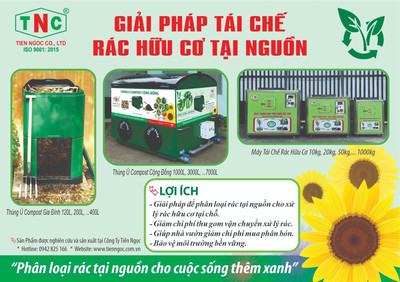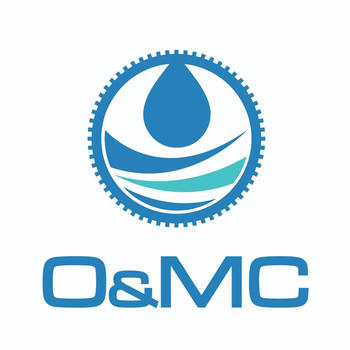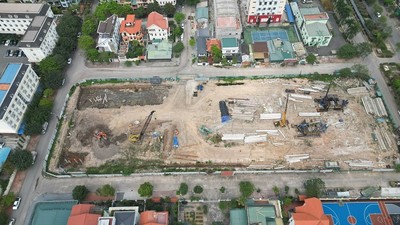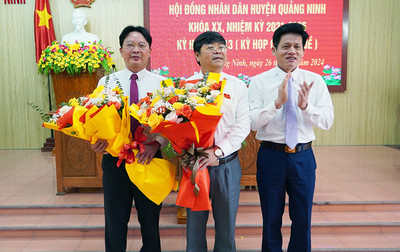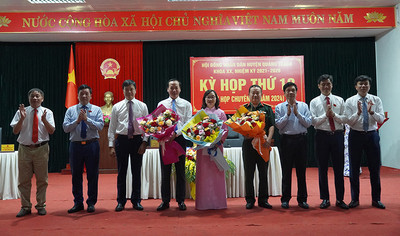Công bố quốc tế lĩnh vực môi trường số 12-2024
Ban biên tập Chuyên trang Quản lý Môi trường, Tạp chí Môi trường và Đô thị Việt Nam trân trọng giới thiệu tới quý độc giả Công bố quốc tế lĩnh vực môi trường số 12-2024.
Về quản lý môi trường
- Ứng dụng học máy trong nghiên cứu ô nhiễm khí quyển: Đánh giá hiện đại.
- Xem xét lại Giả thuyết về đường cong Kuznets môi trường (EKC) về phát thải carbon: Khám phá tác động của rủi ro địa chính trị, tiền thuê tài nguyên thiên nhiên, quản trị tham nhũng và cường độ năng lượng.
- Dòng chảy môi trường tác động như thế nào đến nguồn nước sẵn có trong các kịch bản biến đổi khí hậu ở các lưu vực châu Âu?
- So sánh hoạt động thị trường giao dịch carbon của EU và Trung Quốc và tác động lan tỏa của chúng.
- Con người hay khí hậu? Phân biệt các yếu tố nhân tạo và khí hậu của sự thay đổi lưu trữ hồ trên quan điểm không gian thông qua dữ liệu viễn thám.
- Đánh giá rủi ro sức khỏe khi hấp thụ uranium từ các cơ sở nước uống nước ngầm của khu dân cư tư nhân dựa trên đặc điểm địa chất trên khắp Hàn Quốc.
- Hướng tới thành phố thông minh bền vững: Đổi mới công nghệ có giảm thiểu phát thải CO2 của G7? Bằng chứng mới từ CS-ARDL.
- Hài hòa các tiêu chuẩn chất lượng môi trường thuốc trừ sâu: Một góc nhìn về con đường định mệnh.
- Khung tối ưu hóa khả năng chịu đựng môi trường nước ở quy mô lưu vực.
- Quy mô của chính phủ và mức sẵn sàng chi trả cho chính sách môi trường: Bằng chứng từ một cuộc khảo sát xuyên quốc gia.
Về môi trường đô thị
- Làm thế nào để cụm đô thị Đồng bằng sông Châu Giang có thể đạt được mục tiêu đỉnh carbon: Dựa trên quan điểm về con đường tăng trưởng kinh tế ổn định tối ưu.
- Nhận dạng và phân loại vi nhựa hiệu quả và chính xác trong vùng nước đô thị bằng cách sử dụng mạng lưới thần kinh tích chập.
- Mô phỏng mối quan hệ qua lại giữa dân số, nước, sinh thái và kinh tế trong các quần thể đô thị dựa trên cách tiếp cận động lực hệ thống.
- Dự đoán hai chiều về đặc điểm cacbon hóa thủy nhiệt của chất thải nông lâm kết hợp và chăn nuôi với các thành phần thay đổi: Tái chế chất thải được hỗ trợ bằng mô hình học tập đồ thị.
- Đặc điểm phân chia theo kích thước của tiềm năng oxy hóa hòa tan trong nước ở đô thị Hạ Môn: Các yếu tố thúc đẩy tiềm năng và tác động đối với sức khỏe con người.
- Tác động lan tỏa phát thải carbon xuyên khu vực của Trung Quốc do quá trình đô thị hóa và chuyển dịch công nghiệp.
- Loại bỏ kỵ khí các chất gây ô nhiễm đang là mối quan tâm mới trong nước thải đô thị: Đánh giá rủi ro độc tính sinh thái và lựa chọn chiến lược xử lý tối ưu.
- Đặc điểm mô hình không gian và chính sách tối ưu hóa mức độ đổi mới carbon thấp trong các cụm đô thị ở lưu vực sông Hoàng Hà.
- Dấu chân khu vực xây dựng đô thị (UBAF): Một phương pháp mới để đánh giá sức chứa sinh học đô thị và độ nhạy sinh thái' Mối liên hệ giữa gió biển và vật chất hạt ở năm địa điểm đô thị ven biển ở Ấn Độ.
- Tác động ngắn hạn của việc tiếp xúc với PM2.5 trong môi trường xung quanh và các thành phần của nó đối với việc nhập viện do dọa sẩy thai và tự phát: Một nghiên cứu trường hợp chéo ở nhiều thành phố ở Trung Quốc.
Về môi trường khu công nghiệp
- Chất hấp phụ dựa trên chất thải công nghiệp như một xu hướng mới để loại bỏ các chất gây ô nhiễm mới nổi từ nước.
- Đánh giá kinh tế và môi trường công nghệ của các chiến lược loại bỏ màu khỏi nước thải dệt may.
- Công nghệ lai thế hệ tiếp theo để xử lý nước thải ngành dược phẩm Tiết lộ tính bền vững trong ngành dược phẩm và hóa chất: Kết quả từ phân tích trắc lượng thư mục và so sánh báo cáo tài chính dựa trên AI.
- Tác động của việc công bố thông tin môi trường đến sự phát triển xanh của ngành khai thác mỏ: Bằng chứng từ các tiểu ngành khai thác mỏ cấp tỉnh của Trung Quốc.
- Sự phát triển năng động, sự khác biệt trong khu vực và các yếu tố ảnh hưởng đến sự phát triển chất lượng cao của ngành hậu cần Trung Quốc.
- Ảnh hưởng của tính không đồng nhất đến hiệu quả môi trường: Bằng chứng từ các ngành công nghiệp châu Âu trong các lĩnh vực.
- Đánh giá kinh tế và môi trường của các công nghệ xử lý chất thải y tế cấp ngành – Nghiên cứu điển hình về 10 siêu đô thị của Trung Quốc.
- Thiết kế thí nghiệm tách chiết các hợp chất phenolic từ phụ phẩm công nghiệp thực phẩm bằng dung môi xanh và GRAS - Tổng quan hệ thống.
- Cấu trúc đĩa nano tự lắp ráp của Bi4V2O11 hình bông cải xanh được neo với chất đồng xúc tác Ag-Ag3O4 dưới dạng chất xúc tác quang sơ đồ Z điều khiển bằng ánh sáng mặt trời 3D/0D: Xử lý nước thải ngành dệt may.

CHUYÊN TRANG QUẢN LÝ MÔI TRƯỜNG
Tạp chí Môi trường và Đô thị Việt Nam
Xin trân trọng giới thiệu!
ENVIRONMENTAL MANAGEMENT / QUẢN LÝ MÔI TRƯỜNG
1. Application of machine learning in atmospheric pollution research: A state-of-art review
Science of The Total Environment, Volume 910, 1 February 2024, 168588
Abstract
Machine learning (ML) is an artificial intelligence technology that has been used in atmospheric pollution research due to their powerful fitting ability. In this review, 105 articles related to ML and the atmospheric pollution research are critically reviewed. Applications of ML in the prediction of atmospheric pollution (mainly particulate matters) are systematically described, including the principle of prediction, influencing factors and improvement measures. Researchers can improve the accuracy of the prediction model through three main aspects, namely considering the geographical features of the study area into the model, introducing the physical characteristics of pollutants, matching and optimizing ML models. And by using interpretable ML tools, researchers are able to understand the mechanism of the model and gain in-depth information.
Then, the state-of-art applications of ML in the source apportionment of atmospheric particulate matter and the effect of atmospheric pollutants on human health are also described. In addition, the advantages and disadvantages of the current applications of ML in atmospheric pollution research are summarized, and the application perspective of ML in this field is elucidated. Given the scarcity of source apportionment applications and human health research, standardized research methods and specialized ML methods are required in atmospheric pollution research to connect these two disciplines.
2. Revisiting the Environmental Kuznets Curve (EKC) Hypothesis of Carbon Emissions: Exploring the Impact of Geopolitical Risks, Natural Resource Rents, Corrupt Governance, and Energy Intensity
Journal of Environmental Management, Volume 351, February 2024, 119663
Abstract
The global imperative to mitigate carbon emissions for sustainable development has spurred extensive research into economic, social, and energy-related factors. However, prior studies present a complex landscape, yielding mixed conclusions regarding the influence of geopolitical risk, natural resource rents, corrupt governance, and energy intensity. To untangle this ambiguity, we construct a research model grounded in the Environmental Kuznets Curve, employing panel data from 38 countries spanning 2002 to 2020. Employing panel quantile regression models, we directly assess the impact of identified factors.
Our findings affirm the alignment between economic growth and carbon emissions, supporting the Environmental Kuznets Curve hypothesis. Notably, increased geopolitical risk and energy intensity correlate with heightened carbon emissions over time, while corruption governance and natural resource rents exhibit a mitigating effect. Additionally, our study explores the indirect impact of these factors using a panel threshold regression model. Results indicate a diminishing influence of economic growth on carbon emissions. Intriguingly, natural resource rents initially curtail, then amplify the connection between economic growth and carbon emissions. Conversely, rising energy intensity magnifies the relationship between economic expansion and carbon emissions.
3. How do environmental flows impact on water availability under climate change scenarios in European basins?
Science of The Total Environment, Volume 911, 10 February 2024, 168566
Abstract
Environmental flows (Qeco) facilitate a good ecological status of fluvial ecosystems, but they usually represent a constraint for water uses. Qeco flow regime should not only be based on the minimum flows, but it should also account their variability. It is expected that climate change impact on some hydrological systems diminishing the natural water resources and stressing the river ecosystems. In this context, the balance between ecosystems conservation and human water needs becomes even more difficult to manage. We performed a comprehensive analysis over European territory to assess the behaviour of basins regarding different criteria for environmental flow determination under climate change scenarios. We used a water allocation model, WAAPA, to estimate the water availability (WA). In this study, WA represents the maximum demand that can be supplied at a certain point of the river network with a given reliability criteria, considering drinking and irrigation water supply.
We considered two methods for calculating Qeco, Qeco1 based on mean monthly flow (MMF) and Qeco2 based on mean annual runoff (MAF). We analyzed the current scenario (historical from 1960 to 2000) and 40 future projections, which combine short and long term (from 2020 to 2059, and from 2060 to 2099, respectively), four emission scenarios (RCP2.6 to RCP8.5) and five climate models. Expected changes on MAF due to climate change are not uniform through Europe and also vary regarding the specific climate scenario. >70 % of basins show a trend to reduce their MAF under severe emission scenarios. Conservative values of Qeco represent a heavy constraint for WA and stress the water systems similarly than climate change impacts. The study also highlights that regulation capacity helps on buffering the effects of both climate change and environmental requirements. This study provides a good insight for understanding basin response in terms of WA, regarding environmental criteria and climate change effects.
4. Comparing the EU and Chinese carbon trading market operations and their spillover effects
Journal of Environmental Management, Volume 351, February 2024, 119795
Abstract
A carbon trading market (CTM) policy for trading carbon dioxide emission rights as a commodity was created to reduce greenhouse gas emissions. CTMs operate differently in different countries and regions, and their interactions deserve an in-depth study. This study focused on the world's largest CTM, the European Union (EU), and the CTM of China, largest carbon-emitting country. First, we evaluate the liquidity and volatility of the two CTMs. Subsequently, the VAR model is used to explore the mean spillover effect between the two markets and the BEKK-GARCH model is used to explore the volatility spillover effect between the two markets. The study concludes that: (1) The liquidity of China's CTM is better than that of the EU's CTM. (2) Both the EU and Chinese CTMs are unstable, but the volatility of the Chinese CTM is lower than that of the EU CTM. (3) Price changes in the EU and Hubei CTMs have a mutual influence. (4) There are interactions between the market fluctuations of the EU CTM and the Shanghai CTM and those of the EU CTM and the Hubei CTM. The results of this study have implications for the construction and development of CTMs in the EU and China.
5. Human or climate? Differentiating the anthropogenic and climatic drivers of lake storage changes on spatial perspective via remote sensing data
Science of The Total Environment, Volume 912, 20 February 2024, 168982
Abstract
Lakes are an essential part of the terrestrial water system in which storage changes are controlled by water balance and human impact. Although there are some attempts to define storage changes on a global scale, examination of spatial relations is poorly quantified. In this study, therefore, lake storage changes have been investigated using remote-sensing-derived data around the globe. Hence, 372 artificial/natural lakes were obtained, covering between 1992 and 2019. Watersheds belong to river was extracted via HydroSHED data. Based on watershed, dominant climate types were determined via Köppen-Geiger classification. Similarly, the areal average CRU TS v.4.05 monthly gridded precipitation time series and human footprint data based on watersheds were obtained to understand the drivers of lake storage changes. The nonparametric Mann-Kendall and Sen's slope trend analyses were applied to the lake storage change and precipiation values in order to determine long-term increases and decreases.
A bivariate map was constructed between storage changes trend vs precipitation trend and human footprint to reveal the drivers of lake storage changes in terms of spatial aspects. The trend analysis and bivariate map results show that North America, the East African Highlands, and the Tibet plateau are important increasing hotspots, where precipitation is a significant driver for storage oscillations, except for the Tibet plateau. Besides, the Brazilian Highlands, Pacific Mountain System, and Intermontane of conterminous USA are other decreasing hotspots in which human footprint and decreasing precipitation collectively affect these changes. Furthermore, results clearly show that anthropogenic influence is low in the northern and mountainous areas, and storage changes have a linear relationship with precipitation. In contrast, intense human climate interaction influences lake changes in plains areas and arid/temperate climates.
6. Environmental regulations, technological innovation, and low carbon transformation: A case of the logistics industry in China
Journal of Cleaner Production, Volume 439, 1 February 2024, 140710
Abstract
China is the world's largest emitter of carbon dioxide. The logistics industry is the second largest source of CO2 emissions, second only to the manufacturing industry. Therefore, developing effective environmental regulations to achieve low-carbon transformation in the logistics industry is an urgent task for government managers. Based on the 2005–2021 panel data of China's 30 provinces, this article adopts a data-driven nonparametric additive model to investigate the role of environmental regulations in CO2 emission reduction in the logistics industry. The results display that overall, environmental regulations contribute to carbon reduction in the logistics industry (an inverted N-shaped effect).
After endogeneity test and various robustness tests such as replacing the variable value of core variable, this conclusion still has good reliability. Further heterogeneity analysis indicates that the carbon reduction effect of mandatory environmental regulations fluctuates frequently (a W-shaped impact). However, the carbon reduction impact of incentive environmental regulations has gradually shifted from insignificant in the early stages to prominent in the later stages (an inverted U-shaped pattern).
Regional heterogeneity analysis shows that the impact of environmental regulations on carbon reduction in the eastern, central, and western regions also has significant nonlinear characteristics. Finally, this article verifies that technological innovation and energy consumption structure are effective intermediate mechanisms for environmental regulations to affect emission reduction. The research findings provide practical inspiration for the government to formulate relevant environmental policies and promote the green development of the logistics industry.
7. Health risk assessment of uranium intake from private residential drinking groundwater facilities based on geological characteristics across the Republic of Korea
Science of The Total Environment, Volume 913, 25 February 2024, 169252
Abstract
Groundwater contributes to an average of 8 % of the total water source capacity in the Republic of Korea. Hence, private residential households in rural areas in Korea are still using groundwater for drinking without any regular water quality inspection. This can increase the risk of exposure to natural radionuclides like uranium through drinking groundwater.
This study investigated the uranium level in drinking groundwater all over the country by analyzing 11,451 samples from private residential drinking groundwater facilities and compared the exposure amount and its associated carcinogenic and non-carcinogenic risk based on the geological characteristics of the aquifer. Results yield that although the average hazard quotient (HQ) and excess cancer risk (ECR) of exposure to natural uranium through drinking groundwater were respectively below 1 and 1 × 10−6 and do not indicate a potential health hazard, significantly high HQ and ECR up to respectively 70 and 4 × 10−4 in samples where the aquifer is the Jurassic granite observed. Accordingly, regular water quality investigation and onsite treatment methods are required to provide healthy drinking water in such areas.
8. Long-term implications of municipal solid waste (MSW) classification on emissions of PCDD/Fs and other pollutants: Five-year field study in a full-scale MSW incinerator in southern China
Journal of Cleaner Production, Volume 440, 10 February 2024, 140848
Abstract
Understanding how municipal solid waste (MSW) classification influences the physiochemical properties and incineration emission characteristics of MSW is imperative for sustainable waste management. To investigate how long-term changes in the composition and physical properties of MSW resulting from MSW classification affect the emissions of polychlorinated dibenzo-p-dioxins/dibenzofurans (PCDD/Fs) and multiple flue gas pollutants, a five-year experiment (2018–2022) was conducted in a full-scale MSW incinerator in Shenzhen City, China. After MSW classification, the food waste in MSW was substantially reduced while the paper, textile, and wood components were notably increased. MSW classification also remarkably decreased the water and chlorine contents of MSW while concomitantly increasing the wet-based calorific value, sulfur content, and nitrogen content. Consequently, the PCDD/Fs emissions declined from 106.7 ng I-TEQ/t MSW in 2018 to 26.0 ng I-TEQ/t MSW in 2022.
Moreover, a process-tracing experiment demonstrated noticeable decreases in PCDD/F synthesis in the post-combustion area, with mass-reduction efficiencies of 23.6 %–95.4 %. In a correlation analysis, the PCDD/F emissions were significantly positively correlated with food waste, water content, and chlorine and negatively correlated with the wet-based calorific value and nitrogen content. Furthermore, MSW classification reduced the emissions of conventional flue gas pollutants (SO2, CO, and HCl) and multiple heavy metals (total sum of Sb, As, Pb, Cr, Co, Cu, Mn, and Ni). In summary, the long-term study demonstrated that MSW classification can feasibly separate incombustible waste, improve combustion quality, and reduce pollutant emissions from sources. These findings offer practical guidance for promoting MSW classification.
9. Towards smart sustainable cities: Does technological innovation mitigate G7 CO2 emissions? Fresh evidence from CS-ARDL
Science of The Total Environment, Volume 913, 25 February 2024, 169723
Abstract
Sustainable cities are considered paradigmatic to achieve COP27 targets, but scant literature has analyzed the association with CO2 emission (CE) mitigation policies, especially for the G7 economies. This study traces the impacts of urbanization, innovation, income, and energy consumption on CE for the G7 countries from 1995 to 2019. The time period is important due to the rapid increase in urbanization, globalization, and, at the same time, technology diffusion. The study is focused on novel and relevant panel data econometric methods that tackle cross-section dependence, non-normality of data, and heterogeneity in slope coefficients.
The empirical outcome first confirms the long-run cointegrating relationship among the variables in the presence of structural breaks by employing the advanced panel cointegration test. Technologies related to environmental management and energy consumption are positively linked with CE. However, the role of income per capita is found to be inverse with CE. In contrast, the effect of urbanization in different models is mixed for CE. Innovation and its interaction with urbanization are crucial for limiting CE and promoting sustainable cities in G7 economies. This indicates that urbanization with environment-friendly innovation can help G7 countries foster sustainable cities and achieve COP27 targets in general, specifically the Sustainable Development Goal of sustainable cities. The results were tested for the multiplicative effect of different variables with urbanization and innovation. Regarding policy insights, the study recommends focusing on smart and sustainable cities with environment-related innovations and transitioning towards cleaner energy from conventional energy consumption.
10. The economic and environmental dividends of the digital development strategy: Evidence from Chinese cities
Journal of Cleaner Production, Volume 440, 10 February 2024, 140398
Abstract
Digital development is critical for achieving coordinated regional economic growth, energy conservation, and emissions reduction, which makes it a viable method for achieving carbon neutrality and peaks. This study investigates the impact of the digital economy on urban total factor productivity and carbon emissions, as well as its mechanism, from 2011 to 2019 by developing a digital economy evaluation index system. We find that the growth of the digital economy can increase urban total factor productivity while lowering carbon emissions and also has a significant spatial spillover effect on regional economic growth, energy conservation, and emissions reduction.
The main influencing mechanism is that the digital economy accelerates marketization by encouraging industrial structure upgrades and technological progress, which results in higher total factor productivity and lower energy consumption. In terms of the spatial distribution, the digital economy promotes total factor productivity more in the central and western regions and large cities and promotes carbon emission reduction less in the eastern regions and smaller cities. The findings extend the benefits of the digital economy beyond economic and social welfare benefits and serve as a model for achieving a win–win situation in terms of both economic growth and carbon emissions reduction.
11. Harmonizing pesticides environmental quality standards: A fate-pathway perspective
Chemosphere, Volume 350, February 2024, 141063
Abstract
Regulatory agencies worldwide set pesticide environmental quality standards, which are proposed independently in each dependent environmental media rather than across the complete fate route. Thus, lacking the fate-pathway perspective in defining pesticide environmental quality standards might cause undesirable pesticide residue from the upper compartment (e.g., soil) to the lower compartment (e.g., water).
This study aimed to harmonize the self-consistency of pesticide environmental quality standards across environmental media via the fate-pathway analysis. The introduced qualitative and quantitative rules defined environmental quality standards of pesticides in six major environmental scenarios in the soil and water system based on related regulatory objectives. Fate factors simulated via USEtox were used to create a preliminary quantitative link between theoretical maximum legal masses of pesticides across environmental compartments. Using chlorpyrifos and 2,4-D as examples, their standard values were comparatively assessed in selected environmental media in China and the United States.
According to the investigative findings, missing the respective environmental quality standards of pesticides in the agricultural soil could significantly influence the implementation of those in freshwater. Taking a fate-pathway perspective, the self-consistency test highlighted that defining pesticide environmental quality standards for freshwater was the most challenging task, as the freshwater compartment typically comprises multiple lower environmental compartments with diverse regulatory objectives. Overall, this theoretical study has the potential to illuminate the harmonization of pesticide environmental quality standards throughout the entire environmental fate pathway, ultimately leading to improved regulatory efficiency and communication. Future research should focus on risk-based model implementation, regulatory response evaluation, and legal limit interpretation to better integrate environmental pesticide management under a variety of regulatory goals.
12. An optimization framework for basin-scale water environmental carrying capacity
Journal of Environmental Management, Volume 351, February 2024, 119520
Abstract
The interaction between water environment and social economy at a basin scale is complex and challenging to quantify. To address this issue, this study proposes an integrated framework that builds parametric connections among water, contaminants, administrative regions, and social activities. The framework, known as the water environmental carrying capacity (WECC) optimization framework, effectively captures the intricacy of the interaction and integrates socio-economic parameter structure relationships, a water environmental model, a WECC optimization model, and a sensitivity analysis of regulatory parameters.
Applied to the Anhui-Huaihe Basin in mid-eastern China, the framework considers nine administrative regions and three economic factors: industry, agriculture, and GDP per capita (pGDP). Results show that the current water environmental carrying capacity of the watershed is insufficient to meet socio-economic development requirements. After optimization, the WECC for industry, agriculture, and pGDP in the region increased by 22.40%, 26.59%, and 15.08% respectively. Overall COD and NH4–N discharge decreased by 13.6% and 14.7% respectively, effectively reducing pollution loads in rivers and enhancing sustainable development potential. At the regional scale, optimization for industry, agriculture, and pGDP exhibited different characteristics, but all aimed to improve efficiency by reducing the K value (pollution discharge/output value ratio). Regions with industrial treatment rates (αwt) below 0.8 should prioritize increasing treatment rates, while those above 0.8 should consider industrial upgrading for enhanced efficiency.
For agriculture, important sensitive parameters for farming and livestock breeding are the proportion of high standard farmland (αs) and the scale breeding ratio (αb), which should be increased to above 0.15 and 0.83 respectively for all regions to achieve agricultural optimization. For pGDP optimization, the focus is on improving living environments and reducing pollution discharge, with crucial measures including collecting and treating rural domestic sewage, where the rural toilet improvement rate (αt) in each region should be increased to 0.78 or above. The results emphasize the need for both interregional allocation and intraregional planning to achieve comprehensive basin optimization and a harmonious balance between regional development and water environment.
13. Collective action dilemmas of sustainable natural resource management: A case study on land marketization in rural China
Journal of Cleaner Production, Volume 439, 1 February 2024, 140872
Abstract
Sustainable natural resource management encompasses not only technical aspects but also the capacity and inclination for collective action. Using semi-structured interview data and social network analysis, this paper assesses the characteristics of three elements of social capital (norms, communication networks, and trustworthiness) and their effects on collective action, in the context of the marketization of rural collectively-owned operating construction land (COCL) in Dingluan Town, Henan Province, China. The results reveal that villagers possess a superficial understanding of compensation schemes at the normative-level analysis, impeding effective collective decision-making.
Communication network analysis exposes strong ties that may impede collective action if only information flows within villages. In contrast, weak ties serve as vital bridges promoting marketization. Additionally, we observe that groups with strong ties rely more on key actors for accurate calls to action, underscoring the importance of trustworthiness. More importantly, the results point to three dilemmas regarding land marketization in rural China: cognitive bias of norms, challenges in expressing stakeholders’ demands, and crisis of trust among key actors. We further highlight trust as a potent means of breakthrough to address these dilemmas rooted in normative, communicative, and trust-related aspects that present formidable challenges to collective action. These results provide important insights for trust-building strategies for researchers and policy promoters to solve the collective action dilemma in environmental management.
14. The dampening effect of geopolitical risk and economic policy uncertainty in the linkage between economic complexity and environmental degradation in the G-20
Journal of Environmental Management, Volume 351, February 2024, 119679
Abstract
The question remains whether high geopolitical risk and economic policy uncertainty will have a dampening or enhancing effect on pollution factors. In this regard, the study empirically investigates the effects of economic complexity, geopolitical risk, economic policy uncertainty, renewable energy consumption and economic growth on environmental pollution for G-20 countries from 1997 to 2018.
The long-term coefficient estimates, derived from the FMOLS estimator, support the inverted U-shaped EKC linkages between economic complexity and ecological footprint, carbon footprint and carbon dioxide emissions. Furthermore, over the long term, geopolitical risks, renewable energy use, and the interaction between economic complexity and policy uncertainty have a positive impact on environmental quality in the G-20 economies. Conversely, economic growth and the interaction between economic complexity and geopolitical risk are negatively associated with environmental quality.
Additionally, economic policy uncertainty has a positive effect on ecological footprint carbon footprint and carbon dioxide emissions. Finally, causality results revealed that explanatory variables are the cause of environmental pollution indicators. Hence, in order to advance environmental quality in these nations, precautions must be taken to mitigate the effects of economic policy uncertainty and boost the accessibility of renewable energy sources. Additionally, while not advised as a policy measure, the feasible economic fallout of geopolitical risk should also be considered.
15. Enhancing agricultural environmental performance: Exploring the interplay of agricultural productive services, resource allocation, and marketization factors
Journal of Cleaner Production, Volume 439, 1 February 2024, 140843
Abstract
Exploring the factors that affect agricultural environmental performance enriches our understanding of the environmental implications of agricultural practices. Using panel data for 79 prefecture-level cities in the middle and lower reaches of the Yangtze River in China from 2003 to 2020, this study theoretically determines and empirically tests the relationship between agricultural productive services, resource allocation, and agricultural environmental performance.
The results show that agricultural productive services can significantly improve agricultural environmental performance. Marketization process has a positive moderating function on the direct effect of agricultural productive services on agricultural environmental performance, which increases with the improvement of marketization process. While marketization process has a significant moderating function on the mediating effect of labor misallocation and capital misallocation in both the first and second halves of the path, marketization has a significant moderating function on the mediating effect of land misallocation in the first half of the path. Based on results, we provide reference for agricultural policymakers, especially in countries dominated by smallholder farmers, to design policies on agricultural productive services, agricultural resource allocation, and market-oriented reforms, as well as to formulate differentiated agricultural environmental performance policies.
16. Size of government and willingness-to-pay for environmental policy: Evidence from a cross-country survey
Journal of Environmental Management, Volume 351, February 2024, 119601
Abstract
Citizen support is an important precursor to climate change mitigation polices. Public opinion can shape public policy and vice versa. This paper uses the 2010 International Social Survey Programme (ISSP) Environment Module to investigate cross-national differences in support for climate policy. We introduce size of government, measured by government revenues as a share of GDP, as a new country-level factor. Our sample includes 31,511 responses from 33 countries.
We use multilevel models to estimate the relationship between country-level factors and environmental policy support, conditional on a series of individual factors. Increasing the size of government by one standard deviation reduces support for environmental policy by 0.13 points on a 5-point scale. For comparison, a one standard deviation increase in GDP per capita leads to a 0.24 increase in support and a one standard deviation increase in air pollution leads to a 0.13 point increase. The implication for environmental policy is that high tax countries have an aversion to price and tax increases aimed at protecting the environment. We conclude that use of taxes for environmental policy must include clear expectations for how revenues will be recycled or how other taxes will be lowered if they are to gain widespread support.
URBAN ENVIRONMENT/ MÔI TRƯỜNG ĐÔ THỊ
1. Chemical evolution of rainfall in China's first eco-civilization demonstration city: Implication for the provenance identification of pollutants and rainwater acid neutralization
Science of The Total Environment, Volume 910, 1 February 2024, 168567
Abstract
Rainfall chemistry is a vital indicator for reflecting anthropogenic/natural input on atmospheric quality, and the rainfall process is also the main sink of air contaminants, which has received widely concerns by all walks of life. However, the chemical compositions, sources of major solutes, historical evolution, and their determinants of rainwater in Chinese urban area, which is hotspot of atmospheric pollutant emission, are unclear under the dual background of fast economic development and eco-civilization construction. To decipher these issues, the latest year data of observation-based rainwater chemistry and the historical rainwater data, and air pollution data of China's first eco-civilization demonstration city were integrated and studied.
The results presented that SO42− (53.4 %) and NO3− (28.8 %), Ca2+ (46.5 %) and NH4+ (37.9 %) dominated the present rainwater anions and cations. The historical changes in the relative proportion of rainwater ions (e.g., the holistic decreasing trend of SO42−) revealed the reduction and management achievement of atmospheric pollutant emission driven by different stages of eco-civilization city construction. The atmospheric components were well removed by rainfall scouring and all the rainwater ions showed obvious temporal variations.
The concentrations of most of ions were higher in winter but lower in summer due to the key factors of meteorological factor (mainly rainfall amount) and the seasonal variations of source contribution. The stoichiometry-based source identification and relative contribution calculation reflected that anthropogenic input was the most primary contributor of NO3− (99.4 %) and SO42− (95.4 %), and the contribution of fixed emission source was relatively higher than that of traffic sources. The NH4+ was defined as the anthropogenic input ion (urban wastes and fuel combustion), while all Cl− and Na+ were from oceanic input. In contrast, terrigenous input represented the most important origin of Ca2+, K+, and Mg2+, with relative contribution of 99.5 %, 97.0 %, and 90.7 %, respectively. The high neutralization factor (NF, about 2.0) values and neutralizing to acidifying potential (NP/AP, about 1.7) ratios and their increasing trend in past few decades revealed the fact of rainwater acid being highly neutralized under the background of eco-civilization city construction.
2. How can the Pearl River Delta urban agglomeration achieve the carbon peak target: Based on the perspective of an optimal stable economic growth path
Journal of Cleaner Production, Volume 439, 1 February 2024, 140879
Abstract
The Pearl River Delta (PRD) has high concentrations of energy consumption and carbon emissions, and the conflict between its economic development and environmental protection is relatively prominent. Beginning from the ideal path of economic growth, this study proposes a framework for carbon emission prediction under the optimal economic growth path of the PRD via the cross-analysis of low-carbon economic analysis and artificial intelligence prediction.
First, the generalized Divisia index method (GDIM) is used to decompose carbon emissions to quantify the contribution rate of each influencing factor. Then, the genetic algorithm (GA) is introduced to optimize the backpropagation (BP) neural network to construct a GA-BP combined prediction model. Finally, the optimal economic growth rate models under different scenarios are constructed, and the carbon peak in the PRD under stable economic growth is accurately predicted. The results show that under the optimal economic growth path, the carbon peak in the PRD under the scenario with carbon constraints will be reached in 2029, while that under the scenario without carbon constraints will only begin to appear around 2035. Thus, the achievement of the carbon peak target in the PRD still requires insisting on stringent carbon emission reduction measures.
3. Efficient and accurate microplastics identification and segmentation in urban waters using convolutional neural networks
Science of The Total Environment, Volume 911, 10 February 2024, 168696
Abstract
Microplastics (MPs), measuring less than 5 mm, pose threats to ecological security and human health in urban waters. Additionally, they act as carriers, transporting pollutants from terrestrial systems into oceanic circulation, contributing to global pollution. Recognizing the significance of identifying MPs in urban waters, one potential solution to the time-consuming and labor-intensive manual identification process is the application of a convolutional neural network (CNN). Therefore, having a reliable CNN model that efficiently and accurately identifies MPs is essential for extensive research on MPs pollution in urban waters. In this work, an MPs dataset with complex background was acquired from urban waters in southern China.
The dataset was used to train and validate CNN models, including UNet, UNet2plus, and UNet3plus. Subsequently, the computational and inference performance of the three models was evaluated using a newly collected MPs dataset. The results showed that UNet, UNet2plus, UNet3plus, after being trained for 120 epochs, provided efficient inferences within less than 1 s, 2 s, and 3 s for 100 MPs images, respectively. Accurate segmentation with mIoU of 91.45 ± 5.93 % and 91.08 ± 6.18 % was achieved using UNet and UNet2plus, respectively, while UNet3plus exhibited a lower performance with only 82.21 ± 10.33 % mIoU. This work demonstrated that UNet and UNet2plus deliver efficient and accurate identification of MPs in urban waters. Developing CNN models that efficiently and accurately identify MPs is crucial for reducing manual time, especially in large-scale investigations of MPs pollution in urban waters.
4. Simulating the interrelationships among population, water, ecology, and economy in urban agglomerations based on a system dynamics approach
Journal of Cleaner Production, Volume 439, 1 February 2024, 140813
Abstract
China's urban agglomerations (UAs) gather most of China's population and economy, but they also facing serious water resources crisis and ecological risks. How to manage the interrelationships among the population, water, ecology, and economy (PWEE) in UAs is crucial for the future of China's urbanization development. Based on the system dynamics (SD) approach, we constructed an SD model for simulating the interrelationships among PWEE in UAs, elucidating the intricate nonlinear relationships between elements of the PWEE system through causal feedback processes and model equations.
In addition, we take the Tianshan North slope urban agglomeration (TSNSUA) as an example, which is a representative area where water resources crisis and ecological risk coexist, and designed five scenarios to dynamically simulate the balance of water supply and demand under the high-density population and economic agglomeration, as well as the potential ecological environmental effects in the process of urban spatial expansion. Our findings include: (1) The existing water resources conditions of TSNSUA can continue to support the current population and economic growth rates. If the future development plan follows the status quo continuation scenario, the phenomenon of insufficient water supply will not occur on the premise that the water supply capacity remains at its current highest level. (2) TSNSUA's future urban spatial expansion is predicted to have less overall impact on the ecological environment, and the carbon peak target by 2030 has an opportunity to be achieved. (3) Appropriately reducing the proportion of agricultural water, while strengthening water-saving and ecological protection measures, can ensure that TSNSUA's population and economy maintain a medium to high growth rate. Based on scenario comparison, our recommendation to policymakers is to establish the development objectives of TSNSUA based on the comprehensive development scenario.
5. Exploring the interrelations and driving factors among typical ecosystem services in the Yangtze river economic Belt, China
Journal of Environmental Management, Volume 351, February 2024, 119794
Abstract
Exploring the spatiotemporal characteristics of ecosystem services (ESs) and their drivers is crucial for managers to develop significant scientific policies that further sustainable development. We used the Yangtze River Economic Belt (YREB) to explore the trends, hotspots, and drivers of water yield (WY), soil conservation (SC), carbon sequestration (CS), and food supply (FS) between 2000 and 2020. Similarly, we analyzed relationships among ESs and drivers of the multiple ecosystem services landscape index (MESLI). We used the self-organizing map method to obtain the types and distribution of the ES bundles, revealing the bundles, trade-offs, and synergies among ESs.
The four ESs had an increasing trend, with CS having the highest increase; ES hotspot analysis showed differences among upper, middle, and lower reaches. Constraint lines among ESs and drivers were diverse; the corresponding SC and WY reached thresholds when CS values were 1477.81 and 460.5 t km−2, respectively. When FS values were 67.34 and 86.17 × 104 Yuan·km−2, CS and WY reached their thresholds. All critical drivers of the four ESs were natural factors. The thresholds that the MESLI reached with driver status were 1000 mm (evapotranspiration), 2121 mm (precipitation), 2.42° (slope), 1.46% (soil organic matter), 36.08% (sand), 30.75% (proportion of non-agricultural population), 18.57% (cropland proportion), 1.05 × 104 persons·km−2 (population density), and 84.84% (proportion of non-agricultural industries in total gross domestic product), respectively. FS, water supply, and ecological conservation bundles changed over the 20 years, and trade-offs and synergies among ESs within bundles differed. We revealed the complexity of ESs from multiple perspectives, which will enable the development of ecosystem management and conservation recommendations for the YREB and large-scale economic zones worldwide.
6. Bi-directional prediction of hydrothermal carbonization characteristics of agroforestry and livestock wastes with variable components: Graph learning model-aided waste recycle
Journal of Cleaner Production, Volume 439, 1 February 2024, 140894
Abstract
Agricultural resource management is essential in present-day society. The hydrothermal carbonization (HTC) is a promising technology for recovering valuable resources from wastes. However, there is a paucity of efficient approaches to predict and comprehend the agricultural waste HTC process. Machine learning modeling approaches have emerged as an important tool for simulating thermochemical reaction processes such as HTC. However, previous studies all limit to predicting products properties of single-component HTC, which are contrary to the complex composition of raw materials, and demonstrate poor generalization performance. Herein, the homogeneity graph data is employed to represent the HTC data with variable components. Then, based on graph encoder-decoder transformer method, a bi-directional prediction model is established to model the HTC process of agroforestry and livestock wastes.
In the case of the forward prediction, the model can predict the composition and yield of hydrochar according to the given HTC conditions. The comparisons with the experimental data other than the training and validation datasets show that the prediction accuracy (R2) of ash, carbon and nitrogen contents of the hydrochar are 0.895, 0.908 and 0.840, respectively, which proves the good generalizability of the model.
Moreover, owing to the embedding vector, which connects the reactant data with the product data in HTC, the model can also achieve backward prediction of HTC reaction conditions such as raw material composition and reaction temperature. Furthermore, by dimensionality reduction analysis of the embedding vector in the model, the similarity of any two HTC reactions can be quantified. The established HTC-graph neural network (GNN) model shows both high accuracy and good generalization ability in bi-directional prediction of HTC process. Based on the effectiveness of the proposed model and the given evaluation indexes, the corresponding HTC parameters can be determined, which greatly benefits to the resources saving and energy consumption reduction.
7. Size-segregated characteristics of water-soluble oxidative potential in urban Xiamen: Potential driving factors and implications for human health
Science of The Total Environment, Volume 912, 20 February 2024, 168902
Abstract
Oxidative potential (OP), defined as the ability of particulate matter (PM) to generate reactive oxygen species (ROS), has been considered as a potential health-related metric for PM. Particles with different sizes have different OP and deposition efficiencies in the respiratory tract and pose different health risks. In this study, size-segregated PM samples were collected at a coastal urban site in Xiamen, a port city in southeastern China, between August 2020 and September 2021.
The water-soluble constituents, including inorganic ions, elements and organic carbon, were determined. Total volume-normalized OP based on the dithiothreitol assay was highest in spring (0.241 ± 0.033 nmol min−1 m−3) and lowest in summer (0.073 ± 0.006 nmol min−1 m−3). OP had a biomodal distribution with peaks at 0.25–0.44 μm and 1.0–1.4 μm in spring, summer, and winter and a unimodal pattern with peak at 0.25–0.44 μm in fall, which were different from the patterns of redox-active species.
Variations in the seasonality of fine and coarse mode OP and their correlations with water-soluble constituents showed that the size distribution patterns of OP could be attributed to the combined effects of the size distributions of transition metals and redox-active organics and the interactions between them which varied with emissions, meteorological conditions and atmospheric processes. Respiratory tract deposition model indicated that the deposited OP and the toxic elements accounted for 47.9 % and 36.8 % of their measured concentrations, respectively. The highest OP doses and the excess lifetime carcinogenic risk (ELCR) were found in the head airway (>70 %). However, the size distributions of OP deposition and ELCR in the respiratory tract were different, with 63.9 % and 49.4 % of deposited ELCR and OP, respectively, coming from PM2.5. Therefore, attention must be paid to coarse particles from non-exhaust emissions and road dust resuspension.
8. China’s cross-regional carbon emission spillover effects of urbanization and industrial shifting
Journal of Cleaner Production, Volume 439, 1 February 2024, 140854
Abstract
With rapid urbanization and industrial shifting in China, demographic and industrial relocation leads to cross-regional carbon emission spillovers, which are playing an increasingly important role in regional carbon transfer and growth. However, how urbanization and industrial shifting influence carbon spillover still needs to be clarified. In this study, we use multi-regional input-output (MRIO) and scenario analyses to investigate the carbon spillover effects of urbanization, industrial shifting, and their synergy effect on provincial and sectoral carbon emissions in China during 2012–2017.
The results showed that urbanization in China further increased carbon spillover in the provinces that already have a high spillover. Industrial shifting, as represented by cross-regional trade between sectors, drove changes in cross-regional carbon spillovers and significantly increased the spillover from Henan, Guangdong, and Hebei by 57.7, 29.9, and 23.6 Mt, respectively. By contrast, the synergy effect of urbanization and industrial shifting on carbon spillover was smaller than their separate effects, with Shandong having the highest increase about 0.61 Mt. Furthermore, at the sectoral level, the production and distribution of electricity and heat-power (PEH), smelting and processing of metals (SPM), and mining and washing of coal (MWC) sectors transmitted the largest carbon emission spillover effects among regions. Based on these findings, more fine-grained policy suggestions for assigning responsibility for carbon reductions and mitigation measures at the regional and sectoral levels in the context of urbanization and industrial shifting.
9. Anaerobic removal of contaminants of emerging concern in municipal wastewater: Eco-toxicological risk evaluation and strategic selection of optimal treatment
Science of The Total Environment, Volume 912, 20 February 2024, 168895
Abstract
In the last decades, the interest for anaerobic process as a mainstream treatment of municipal wastewater increased due to the development of high-rate anaerobic bioreactors able to achieve removal kinetics comparable to the aerobic ones. Moreover, they have the additional advantages of energy production, nutrient recovery and reduced excess sludge yield, which are interesting features in the frame of sustainability wastewater treatment goals. These appealing factors increased the research demand to evaluate the potential of the anaerobic removal for contaminants of emerging concern (CECs) in municipal wastewater.
However, despite the growing interest for the subject, literature is still fragmentary and reviews are mainly focused on specific technologies and target compounds or groups of compounds. We propose this review with the main objectives of presenting the state of knowledge, the performances of anaerobic systems for CECs' removal and, more important, to give the reader guidelines for optimal treatment selection. In the first part, a general overview of the investigated technologies at different scale, with a special focus on the recently proposed enhancements, is presented. Collected data are analysed to select the target CECs and the analysis results employed to define the optimal technological solution for their removal. A first novelty element of the paper is the original procedure for contaminant selection consisting of a risk assessment tool for CECs, based on their frequency of detection, concentration and potential for biosorption in wastewater treatment plants. Data of selected target CECs are combined with compound and technology performance data to implement a flowchart tool to evaluate the optimal treatment strategy, which constitute another, even more important, novelty element of this study.
10. Spatial pattern characteristics and optimization policies of low-carbon innovation levels in the urban agglomerations in the Yellow River Basin
Journal of Cleaner Production, Volume 439, 1 February 2024, 140856
Abstract
This paper refines a comprehensive index of urban low-carbon innovation based on urban low-carbon innovation concept and an urban low-carbon innovation community structure and function. This index is complemented by an indicator reflecting equity in terms of urban-rural income gap, some indicators of low-carbon knowledge and technology innovation, as well as an indicator of the characteristics of a carbon circular economy, and a further refinement of the indicator of low-carbon innovation system. We use the entropy value method, kernel density analysis, gravity model, and social network analysis to study the low-carbon innovation spatial pattern in urban agglomerations (UAs) of the Yellow River Basin (YRB). Innovations in the findings are: (1) the low-carbon innovation level in the UAs in the YRB decreases in spatial distribution from the downstream to the midstream to the upstream UAs. (2) Reveal the spatial pattern laws of low-carbon innovation levels in different types of UAs in the YRB.
The spatial pattern in regional level UAs is more complex and hierarchical than that in area level UAs; but there are still gaps in the hierarchy of spatial patterns of low-carbon innovation levels between UAs at the regional level, as well as between UAs at the area level. The spatial pattern of two regional-level UAs in the YRB is transitioning from a low-carbon innovation point-axis to a low-carbon innovation network structure, and the spatial pattern of one regional-level UAs is at the embryonic stage of the low-carbon innovation point-axis structure.
The spatial pattern of one area-level UA is at the embryonic stage of a low-carbon innovation point-axis structure, and the spatial pattern of three area-level UAs is at the stage of low-carbon innovation pole. The spatial pattern of low-carbon innovation becomes more complex and hierarchical as we move from upstream to midstream to downstream UAs. (3) Use social network analysis and the study show that the low-carbon innovation network is dominated by the internal correlations among the UAs in the upstream, midstream, and downstream. The low-carbon innovation linkages between upstream, midstream and downstream UAs are weak. Finally, we put forward corresponding policy recommendations.
11. Association between sea-land breeze and particulate matter in five coastal urban locations in India
Science of The Total Environment, Volume 913, 25 February 2024, 169773
Abstract
Particulate matter less than 2.5 μm particle diameter (PM2.5) is the most significant environmental issue globally. PM2.5 is an integral component of air quality monitoring and management, human health, weather, climate, and epidemiological research. In this work, we investigate the seasonal variation in PM2.5 mass concentrations and the association between the sea-land breeze system and particulate matter in five coastal urban locations in India (Kolkata, Visakhapatnam, Chennai, Thiruvananthapuram, and Mumbai). The relative occurrence of high PM2.5 mass concentrations was the greatest during the winter season (December through February) while the relative occurrence of low PM2.5 mass concentrations was the greatest during the monsoon season (June through September). Amongst locations, Kolkata experiences the highest PM2.5 loading in winter while Thiruvananthapuram experiences the lowest PM2.5 loading in monsoon.
Indo-Gangetic Plain (IGP) outflow onto the Bay of Bengal significantly impacts locations along the eastern coast of India with reduced impact from north (Kolkata) to south (Chennai). The sea-breeze component analysis revealed daily cycles of the sea-land breeze with varying magnitudes of the breeze between the different seasons. Overall, we found a negative association between the sea-land breeze magnitude and PM2.5 mass concentrations, implying that the weakened sea-land breeze may deteriorate air quality in coastal locations due to poor ventilation. The vertical profiles of aerosol extinction showed elevated aerosol layers within 1 km from the surface in almost all locations. The decreasing trend in the land-sea temperature contrast in coastal locations is expected to deteriorate air quality in coastal locations in the warming future. Nevertheless, critical analyses using ground-based remote sensing techniques are required for a better understanding the impact of sea-land breeze dynamics on air quality in coastal locations.
12. Urban built-up area footprint (UBAF): A novel method of urban bio-capacity and ecological sensitivity assessment
Journal of Cleaner Production, Volume 440, 10 February 2024, 140846
Abstract
In the city level, urban ecological footprint (UEF) assessment is used for a variety of measures, from biological resources through people as well as human population as a whole. But, the context of this study is sightly specific, here we focus built-up land consumption coming out the general concept of UEF. This study used to figure out the urban built-up area footprint (UBAF) as well as bio-productive status in a city scale, and its impact on urban ecological sensitivity (UES). For this assessment, one of the fastest growing-up cities in Eastern Himalayan region of India, namely Siliguri Municipal Corporation (SMC) is selected as a study area.
To assess the UEF and bio-capacity (BC), the yield and equivalent factors have been introduced. Further, variable weights combination (VWC) method is used to assess the UES of SMC. The result shows that increasing UBAF directly impacted on bio-capacity of SMC area. Most of the lands have been converted into built-up land, and highly ecological deficit is seen in the built-up land areas. Thus, the SMC is already crossed the standard limit of the UBAF limit (>3 ha per capita). Consequently, entire SMC has been ecologically sensitive and facing ecological deficit condition rigidly. Therefore, a UBAF based environmental impact assessment framework has been proposed for city level that can be helpful for the further urban land use planning.
13. Urban unemployment, environmental preservation and trade policies in a small open economy with open access renewable resources
Journal of Cleaner Production,Volume 440, 10 February 2024, 140912
Abstract
This study presents a two-sector dynamic analytical model that examines the impact of trade policies on urban poverty reduction and resource conservation, given that institutionally fixed high urban wages are assumed in the context of the Harris-Todaro model. Rural resource-good and urban manufacturing activities generate simultaneous environmental pressures that can detrimentally impact environmental preservation in a small, open economy. Moreover, this study assumes that the polluting manufacturing sector is the primary cause of environmental degradation and represents a relatively more industrialized developing country.
The study finds that raising the import tax on rural resource goods can reduce urban unemployment but worsen environmental quality under dynamic resource conditions. Given institutional distortions, the most efficient policy is to implement a rural income subsidy combined with an urban wage subsidy at a lower rate; alternatively, if the income inequality between regions is sufficiently high, an income tax on urban manufactured goods could be considered. Finally, when considering the endogenous resolution of institutional distortions, an increase in the import tax on rural resource goods can resolve rural institutional distortions, shifting from poorly defined resource management to a perfect private management system. In contrast, implementing an export tariff policy on urban manufactured goods reduces the incentive for rural institutional reform while addressing urban institutional failure.
14. Short-term effects of exposure to ambient PM2.5 and its components on hospital admissions for threatened and spontaneous abortions: A multicity case-crossover study in China
Chemosphere, Volume 350, February 2024, 141057
Abstract
Background
The adverse effects of short-term exposure to PM2.5 and its components on hospital admissions for threatened and spontaneous abortions (TSAB) are still controversial.
Methods
Data on daily hospitalizations for TSAB and PM2.5 and its components, including sulfate (SO42−), nitrate (NO3−), ammonium salt (NH4+), organic matter (OM), and black carbon (BC), were collected from January 2015 to December 2021 (total 2,557 days) in five cities in China. Case-crossover analyses were conducted to investigate the short-term associations between PM2.5 and its components and TSAB. Additionally, the modification effects by age (<35 and ≥35 years), season (cold and warm seasons), and the "Three-Year Action Plan to Win the Blue Sky Defense War” (before and after implementation) on the above associations were further conducted.
Results
For each 10 μg/m3 (1 μg/m3 for BC) increase, the strongest relative risks (95% confidence intervals) of hospitalization for TSAB were 1.011 (1.001–1.021) for PM2.5 in lag02, 1.060 (1.003–1.120) for SO42− in lag02, 1.035 (1.000–1.070) for NO3− in lag02, 1.065 (1.009–1.124) for NH4+ in lag02, 1.047 (1.008–1.088) for OM in lag01 and 1.029 (1.005–1.054) for BC in lag02 (all P <0.05). Furthermore, significant modifying effects of age and the Action Plan were found. The effects of NO3− (lag2), NH4+ (lag2), and BC (lag2) were more pronounced in mothers aged ≥35 years and the effects of PM2.5 (lag4), NO3− (lag4), NH4+ (lag4), OM (lag4), and BC (lag4) was more pronounced in the period before the Action Plan was implemented (all P modification <0.05).
Conclusion
Short-term exposure to ambient PM2.5 and its components (SO42−, NO3−, NH4+, OM, and BC) was related to increased risks of hospitalization for TSAB. The effects were more pronounced in mothers aged ≥35 years and the period before the Action Plan.
15. Deep learning, geometric characterization and hydrodynamic modeling for assessing sewer defect impacts on urban flooding: A case study in Guangzhou, China
Journal of Environmental Management, Volume 351, February 2024, 119689
Abstract
Deep learning techniques have offered innovative and efficient tools for accurate and automated detection of sewer defects by leveraging large-scale sewer data and advanced feature learning algorithms. However, there has been a lack of thorough characterization of the geometric properties of segmented defects, let alone systematically calculate the severity level of sewer defects and quantitatively evaluate their impacts on flood conditions in hydrodynamic models. This study proposed a comprehensive framework and related metrics to accurately and automatically detect, segment, characterize, and evaluate the impacts of sewer defects on flooded nodes and volumes by integrating a DeepLabv3+-based segmentation technique, an automated geometric characterization and severity quantification module, and a GIS and SWMM-based hydrodynamic modeling.
The results clearly showed in details where and how much the urban flooding was affected by the different defect types. The segmentation model achieved satisfactory detection performance, with mean pixel accuracy (MPA), mean intersection over union (MIoU), and frequency weighted intersection over union (FWIoU) of 0.99, 0.74 and 0.95, respectively. In terms of severity level quantification, there were 98%, 90%, 90% and 83% of predictions consistent with real conditions for falling off, obstacle, disjoint and leakage. It was shown that the number of surcharging manholes and total flood volume (TFV) were greatly affected by sewer defects, with over 16% increase in TFVs under all investigated rainfall events. The results addressed the impacts of sewer defects on urban flooding and demonstrated the powerful tools provided by the proposed framework for decision-making on sewer defect detection and management.
16. Spatiotemporal patterns of urban forest carbon sequestration capacity: Implications for urban CO2 emission mitigation during China's rapid urbanization
Science of The Total Environment, Volume 912, 20 February 2024, 168781
Abstract
Urban forests provide ecological functions and human well-being. However, spatiotemporal changes in urban forest carbon sequestration (CS) under rapid urbanization remain poorly understood. We established a model to predict the annual CS dynamics in urban forests based on plot-measured CS and Landsat images. Our results showed that the urban forest coverage in Changchun increased from 18.09 % to 24.01 % between 2000 and 2019, especially in the urban suburbs. However, urban forest patches became more fragmented and less connected, particularly in the urban center.
The NDVI is better than other vegetation indices for mapping urban forest CS. We observed a gradual increase in urban forest CS capacity from 2000 to 2019, with higher CS capacity found in urban suburbs compared to urban centers. The class distribution of urban forest CS capacity was skewed toward low values (0–2 g·m−2·d−1), but this tendency diminished gradually. In 2000, the urban forest in Changchun offset approximately 2.11 % of carbon emissions but declined to 0.88 % by 2019 due to increased carbon emissions. Rapid urbanization was the main factor affecting CS, with impervious surface area accounting for 48.7 % of the variation. Urban landscape pattern indices also influenced the CS, with higher forest patch connectivity and lower patch density leading to greater CS capacity. Our study helps urban managers develop urban greening strategies for carbon neutrality and low-carbon city.
INDUSTRIAL AREA ENVIRONMENT / MÔI TRƯỜNG KHU CÔNG NGHIỆP
1. Utilizing machine learning algorithm for finely three-dimensional delineation of soil-groundwater contamination in a typical industrial park, North China: Importance of multisource auxiliary data
Science of The Total Environment, Volume 911, 10 February 2024, 168598
Abstract
Intensive industrial activities cause soil contamination with wide variations and even perturb groundwater safety. Precision delineation of soil contamination is the foundation and precondition for soil quality assurance in the practical environmental management process. However, spatial non-stationarity phenomenon of soil contamination and heterogeneous sampling are two key issues that affect the accuracy of contamination delineation model. Taking a typical industrial park in North China as the research object, we constructed a random forest (RF) model for finely characterizing the distribution of soil contaminants using sparse-biased drilling data. Results showed that the R2 values of arsenic and 1,2-dichloroethane predicted by RF (0.8896 and 0.8973) were greatly higher than those of inverse distance weighted model (0.2848 and 0.2908), indicating that RF was more adaptable to actual non-stationarity sites.
The back propagation neural network algorithm was utilized to establish a three-dimensional visualization of the contamination parcel of subsoil-groundwater system. Multiple sources of environmental data, including hydrogeological conditions, geochemical characteristics and anthropogenic industrial activities were integrated into the model to optimize the prediction accuracy. The feature importance analysis revealed that soil particle size was dominant for the migration of arsenic, while the migration of 1,2-dichloroethane highly depended on vertical permeability coefficients of the soil. Contaminants migrated downwards with soil water under gravity-driven conditions and penetrated through the subsoil to reach the saturated aquifer, forming a contamination plume with groundwater flow. Our findings afford a new idea for spatial analysis of soil-groundwater contamination at industrial sites, which will provide valuable technical support for maintaining sustainable industry.
2. Industrial waste-based adsorbents as a new trend for removal of water-borne emerging contaminants
Environmental Pollution, Volume 343, 15 February 2024, 123140
Abstract
Emerging contaminants in wastewater are one of the growing concerns because of their adverse effects on human health and ecosystems. Adsorption technology offers superior performance due to its cost-effectiveness, stability, recyclability, and reliability in maintaining environmental and health standards for toxic pollutants. Despite extensive research on the use of traditional adsorbents to remove emerging contaminants, their expensiveness, lack of selectivity, and complexity of regeneration remain some of the challenges. Industrial wastes viz. blast furnace slag, red mud, and copper slag can be used to develop efficacious adsorbents for the treatment of emerging contaminants in water.
Advantages of the use of such industrial wastes include resource utilization, availability, cost-effectiveness, and waste management. Nevertheless, little is known so far about their application, removal efficacy, adsorption mechanisms, and limitations in the treatment of emerging contaminants. A holistic understanding of the application of such unique industrial waste-derived adsorbents in removing emerging contaminants from water is need of the hour to transform this technology from bench-scale to pilot and large-scale applications.
This review investigates different water treatment techniques associated with industrial waste-based adsorbents derived from blast furnace slag, red mud, and copper slag. Besides, this review provides important insights into the growing trends of utilizing such novel types of adsorbents to remove emerging contaminants from water with an emphasis on removal efficacy, controlling measures, adsorption mechanisms, advantages, and limitations. The present timely review brings the current state of knowledge into a single reference which could be a strong platform for future research in understanding the latest advancements, decision making, and financial management related to the treatment of wastewater using industrial waste-based adsorbents.
3. Techno-environmental and economic assessment of color removal strategies from textile wastewater
Science of The Total Environment, Volume 913, 25 February 2024, 169721
Abstract
The textile industry is one of the most chemical-intensive processes, resulting in the unquestionable pollution of more than a quarter of the planet's water bodies. The high recalcitrant properties of some these pollutants resulted on the development of treatment technologies looking at the larger removal efficiencies, due to conventional systems are not able to completely remove them in their effluents. However, safeguarding the environment also implies taking into account indirect pollution from the use of chemicals and energy during treatment. On the other hand, the emerged technologies need to be economically attractive for investors and treatment managers. Therefore, the costs should be kept under control. For this reason, the present study focuses on a comparative Life Cycle Assessment and Life Cycle Costing of four scale-up scenarios aiming at mono and di-azo reactive dyes removal from textile wastewater.
Two reactors (sequencing batch reactor and two-phase partitioning) were compared for different reaction environments (i.e., single anaerobic and sequential anaerobic-aerobic) and conditions (different pH, organic loading rates and use of polymer). In accordance with the results of each scenario, it was found that the three technical parameters leading to a change in the environmental profiles were the removal efficiency of the dyes, the type of dye eliminated, and the pollutant influent concentration. The limitation of increasing organic loading rates related to the biomass inhibition could be overcame through the use of a novel two-phased partitioning bioreactor.
The use of a polymer at this type of system may help restore the technical performance (84.5 %), reducing the toxic effects of effluents and consequently decreasing the environmental impact. In terms of environmental impact, this is resulting into a reduction of the toxic effects of textile effluents in surface and marine waters compared to the homologous anaerobic-aerobic treatment in a sequencing batch reactor. However, the benefits achieved for the nature comes with an economic burden related to the consumption of the polymer. It is expected that the cost of investment of the treatment with the two-phase partitioning bioreactor rises 0.6–8.3 %, depending on market prices, compared to the other analyzed sequential anaerobic-aerobic technologies. On the other side, energy and chemical consumption did not prove to be limiting factors for economic feasibility.
4. Research on the relationship between the innovation environment, carbon intensity, and the information industry in China
International Review of Economics & Finance, Available online 20 February 2024
Abstract
Due to climate concerns, the pursuit of green, low-carbon, and sustainable development has become a primary objective for many nations worldwide. Thus, this study employs panel data from 30 Chinese provinces from 2009 to 2019 to investigate the relationship between the innovation environment, carbon intensity, and the information industry, with specific focus on the emphasis on national innovations, the level of technological innovations, and the transformation of innovations. According to the findings, a favorable innovation environment can significantly mitigate carbon dioxide emissions, while the growth of the information industry can help advance this environment.
5. Next-generation hybrid technologies for the treatment of pharmaceutical industry effluents
Journal of Environmental Management, Volume 353, 27 February 2024, 120197
Abstract
Water and industries are intangible units of the globe that are always set to meet the population's demand. The global population depends on one-third of freshwater increasing the demand. The increase in population along with urbanization has polluted the fresh water resources. The pharmaceutical industry is marked as an emerging contaminant of water pollution. The most common type of pharmaceutical drugs that are detected in the environment includes antibiotics, analgesics, NSAIDs, and pain-relieving drugs. These drugs alter the food chain of the organisms causing chaos mainly in the marine ecosystem. Pharmaceutical drugs are found only in shallow amounts (ng/mg) they have a huge impact on the living system.
The consumption of water contaminated with pharmaceutical ingredients can disrupt reproduction, hormonal imbalance, cancer, and respiratory problems. Various methods are used to remove these chemicals from the environment. In this review, we mainly focused on the emerging hybrid technologies and their significance in the effective treatment of pharmaceutical wastewater. This review paper primarily elaborates on the merits and demerits of existing conventional technologies helpful in developing integrated technologies for the modern era of pharmaceutical effluent treatment.
This review paper further in detail discusses the various strategies of eco-friendly bioremediation techniques namely biostimulation, bioaugmentation, bacterial degradation, mycoremediation, phytoremediation, and others for the ultimate removal of pharmaceutical contaminants in wastewater. The review makes clear that targeted and hybrid solutions are what the world will require in the future to get rid of these pharmacological prints.
6. Sustainability disclosure in the pharmaceutical and chemical industries: Results from bibliometric analysis and AI-based comparison of financial reports
Journal of Cleaner Production, Available online 27 February 2024, 141511
Abstract
Climate change is a pressing global challenge, and companies are under increasing pressure to adopt sustainable practices and transparently disclose their environmental performance. This study focuses on the Italian pharmaceutical industry to gain insights into the level of stakeholder and management attention to climate change and the growth of academic research in this critical area. We employ a bibliometric analysis of scientific literature and a content analysis of financial statements to examine sustainability practices and reporting in both pharmaceutical and chemical companies.
Our findings reveal a significant difference in stakeholder expectations and commitment to addressing climate change between the two industries. The chemical industry has demonstrated a stronger focus on sustainability, as evidenced by higher academic research and environmental disclosure levels. In contrast, the pharmaceutical sector has shown a comparatively lower level of environmental reporting and sustainability practices. However, our analysis shows a positive trend in pharmaceutical companies’ voluntary disclosure of environmental information in their financial reports.
These results highlight the need for increased focus and effort in the pharmaceutical industry to address climate change and improve sustainability practices. Pharmaceutical companies can build stakeholder trust, improve environmental sustainability, increase transparency in reporting, align practices with global sustainability goals, enhance their reputation, and reduce their environmental impact. This research provides valuable guidance for policymakers, researchers and practitioners in promoting sustainable practices in the pharmaceutical industry and contributes to the broader understanding of ESG disclosure and climate change.
7. Effects of environmental information disclosure on the green development of mining industry: Evidence from Chinese provincial mining sub-sectors
Resources Policy, Volume 89, February 2024, 104669
Abstract
How environmental information disclosure (EID) affects green transformation of mining industry (MI) is still unknown. Based on the panel data of China's provincial mining sub-sectors, this study explores the effects of EID on the green total factor productivity (GTFP) of China's mining sub-sectors and its influence mechanism. The research shows that EID exerts an inverted U-shaped influence on the GTFP growth of MI, implying that reasonable EID facilitates the green transformation of China's MI, while excessively EID requirements may be counterproductive.
The above conclusion still holds after considering the endogeneity and conducting a series of robustness tests. Further analysis shows that the impact of EID on the GTFP of MI has a lag and long-term, and the current EID affects its future GTFP. Meanwhile, EID has a more remarkable effect on the GTFP of the MI in the eastern and central regions and the mining and washing of coal (S3) and extraction of petroleum and natural gas (S4). Mechanism analysis reveals that EID affects the GTFP of the MI through technological innovation, but due to the ‘black expected effect’, EID is still unable to increase the GTFP of the MI through energy structure. This study provides important insights for the government to fully leverage the positive role of social supervision in promoting the green development of heavy polluting industries such as MI.
8. Dynamic evolution, regional differences and influencing factors of high-quality development of China’s logistics industry
Ecological Indicators, Volume 159, February 2024, 111728
Abstract
Promoting high-quality development of logistics industry (LHQD) becomes imperative to decrease logistics costs in real economy and intensify endogenous power of economic development. In this paper, we construct an evaluation system consisting of 21 indicators in four dimensions: output scale, operation quality, social contribution and green development. Thereafter, we apply improved entropy weight method, kernel density estimation and Dagum Gini coefficient to carve out spatial and temporal distribution, dynamic evolution and regional differences of LHQD. Finally, we adopt geographical and temporal weighted regression (GTWR) model to reveal heterogeneous effect of each selected factor on LHQD. Outcome indicates: (1) The level of LHQD rose at average annual growth rate of 2.776% between 2004 and 2018, however with significant regional and inter-provincial differences. (2) The LHQD in the whole nation and the three major regions were bipolar or multipolar, with distinctive gradient characteristics. (3) The overall difference of LHQD primarily came from deviation in growth among three major regions, and this difference kept expanding. (4) The impact of various factors on LHQD was characterized by spatial and temporal heterogeneity. Specifically, the positive impact of innovation capacity, digitalization level, foreign direct investment, transportation infrastructure and environmental regulation on development of logistics industry gradually increased with time. It was stronger for eastern region than western region. In contrast, industrial agglomeration’s stimulus to LHQD had diminished, and the high-value region of its positive impact had shifted from east to center.
9. The effect of heterogeneity on environmental efficiency: Evidence from European industries across sectors
Journal of Cleaner Production, Volume 441, 15 February 2024, 141036
Abstract
Due to the immense pressure of environmental pollution, economic growth and energy usage, green growth is recognized as the fundamental development strategy in Europe. This paper assesses environmental efficiency (ENE) of 54 industries from 28 European countries across the three sectors of an economy over the 2000–2014 period using a non-radial directional distance function (DDF). The aim of this study is to shed light and provide a deeper understanding of the different levels of technological heterogeneity that exist among industries by incorporating the metafrontier approach under distinct sector and country-specific production frontiers. The results reveal that industries present higher levels of environmental efficiency within their sectors while manufacturing industries achieve the lowest progress in environmental efficiency. Thus, it is critical to introduce and implement sector-oriented policies rather than common guidelines for all European countries.
10. How does industrial intelligence affect total-factor energy productivity? Evidence from China’s manufacturing industry
Computers & Industrial Engineering, Volume 188, February 2024, 109901
Abstract
The flourishing industrial intelligence profoundly impacts manufacturing production, while empirical studies about the nexus between industrial intelligence and energy issues remain insufficient. This study evaluates total-factor energy productivity based on the stochastic frontier analysis (SFA) approach and then analyzes the energy productivity effects of industrial intelligence by employing the panel data of China’s manufacturing industry. We find that the total-factor energy productivity shows vast regional differences, and most regions have experienced a decline.
Additionally, industrial intelligence significantly improves total-factor energy productivity, and the core results still hold after a set of robustness tests. Mechanism tests reveal the positive effects are mainly due to technological change and industrial structure upgrading. Heterogeneity analysis indicates that the impact of industrial intelligence is more pronounced in regions with higher economic development, more advanced information technology, and greater human capital. These findings provide insightful references for further intellectualization and carbon reduction in China’s manufacturing industry.
11. A high-resolution (0.1° × 0.1°) emission inventory for the catering industry based on VOCs and PM2.5 emission characteristics of Chinese multi-cuisines
Atmospheric Environment, Volume 319, 15 February 2024, 120314
Abstract
Catering enterprises gather in densely populated areas, whose pollutant emission has an important impact on human health and environmental quality. This study investigated detailed information of 5456 catering enterprises in a typical city, and analyzed PM2.5 and VOCs components of 15 catering cuisines and different scales. Based on the measured emission factors, the basic information of nationwide catering enterprises and the population density, this study established the national catering pollutant emission inventory with the spatial resolution of 0.1° × 0.1°. As the results showed, alkanes, alkenes and oxygenated volatile organic compounds (OVOCs) were the main components in VOCs of most catering cuisines, accounting for 36.6%–96.7%, while organic carbon (OC) was the dominant component in PM2.5, accounting for 55.4%–68.6%.
The same cuisine of different scales also presented certain differences in emission characteristics. The total emissions of the ozone formation potential (OFP) and secondary organic aerosols formation potential (SOAFP) were 1737.8 kt and 76.4 kt, respectively, with alkanes and OVOCs being the main contributors, contributing 27.5% and 22.3%, respectively. Acetaldehyde, ethylene, propylene and the other top ten VOC species contribute 81.0% of the total OFP emissions, while toluene contributed much more to total SOAFP emissions than other VOC species, contributing 35.9%. The air pollutant emissions showed the highest correlation with the population, and the regions with prominent emissions were mainly concentrated in the Beijing-Tianjin-Hebei (BTH) region and coastal cities. This study is a systematic understanding of air pollutant emission characteristics of the catering industry in China, which has important supporting value for pollutant emission reduction planning in the catering industry.
12. Environmental and economic assessments of industry-level medical waste disposal technologies – A case study of ten Chinese megacities
Waste Management, Volume 174, 15 February 2024, Pages 203-217
Abstract
Medical waste (MW) is exploding due to the COVID-19 pandemic, posing a significant environmental threat, and leading to the urgent requirement for affordable and environmentally friendly MW disposal technologies. Prior research on individual MW disposal plants is region-specific, applying these results to other regions may introduce bias. In this study, major MW disposal technologies in China, i.e., incineration technologies (pyrolysis incineration and rotary kiln incineration), and sterilization technologies (steam sterilization, microwave sterilization, and chemical disinfection) with residue landfill or incineration were analyzed from an industry-level perspective via life cycle assessment (LCA), life cycle costing (LCC) and net present value (NPV) methods. Life cycle inventories and economic cost data for 4–5 typical companies were selected from 128 distinct enterprises and academic sources for each technology.
LCA results show that microwave sterilization with residue incineration has the lowest environmental impact, emitting only 480 kg CO2 eq. LCC and NPV analyses indicate that steam sterilization with landfilling is the most economical, yielding revenues of 1,210 CNY/t and breaking even in the first year. Conversely, pyrolysis and rotary kiln incineration break even between the 4th and 5th years. Greenhouse gas emissions from the MW disposal in ten cities with the largest MW production in 2020 increased by 7% over 2019 to 43,800 tons and other pollutants increased by 6% to 12%. Economically, Shanghai exhibits the highest cost-effectiveness, while Nanjing delivers the lowest. It can be observed that the adoption of optimal environmental technologies has resulted in a diminution of greenhouse gas emissions by 279,000 tons and energy conservation of 1.76 billion MJ.
13. Design of experiments for green and GRAS solvent extraction of phenolic compounds from food industry by-products - A systematic review
TrAC Trends in Analytical Chemistry, Volume 171, February 2024, 117536
Abstract
Concerning the high impact of climatic change in the environment, the scientific community has focused on a circular economy perspective and the revalorization of waste generated by the food industry for bioactive uses. These applications are possible due to the presence of bioactive compounds in these food wastes. In this sense, phenolic compounds highlight for their positive health implications, as they possess potent activity to prevent diseases such as cancer, inflammation and obesity, among others. For this purpose, the optimized extraction of these target compounds from by-products with a novel green chemistry approach, by using environmentally clean and friendly extraction techniques, commonly known as green extractions, as well as those permitted in foods and safe for health (GRAS solvents) is commonly applied.
Following this research line, a systematic review was conducted using different databases (Web of Science, PubMed and Scopus) following PRISMA guidelines to assess the optimization of different green and GRAS solvent extraction techniques from food by-products, the best extraction conditions, as well as the experimental design applied to obtained maximum amounts of the compounds of interest, considering the research published to date. Thus, 67 studies of 282 records identified met the inclusion criteria. A distinction has been made between the different technologies used in the extraction processes, paying special attention to the experimental designs applied and the optimized independent variables. Finally, a quantitative and qualitative comparison was made between the different matrices studied.
14. Environmental regulations implemented by local officials in China: Is there a hometown effect?
Energy Economics, Volume 130, February 2024, 107340
Abstract
The emotional connection of the people-hometown relationship is an informal but important mechanism in environmental regulation. Based on firm-level Pollution Database in China, this study explores the impacts and mechanisms of the emotional connection between local officials and their hometowns in the implementation of environmental regulation. We found that (1) in the implementation of environmental regulation, the presence of native local officials (i.e., those serving in their home province) leads to a significant reduction in the exhaust gas emissions of industrial enterprises within their jurisdiction, which we call the "hometown effect” of local officials in environmental regulation; (2) Mechanism analysis shows that native local officials enforce stricter environmental regulations, manifested in reduced approval for the entry of polluting firms and less land transfer for developing key polluting industries. Simultaneously, firms are observed with remarkable improvements in their environmental protection technologies, with advancements in pre-emission reduction technology, post-treatment technology, and post-treatment efficiency within the jurisdiction of native local officials; (3) The trade-off between local environment quality and economic growth can be explained within the framework of local accountability. Additionally, the study reveals that the "hometown effect” of local officials in pollution control becomes larger in regions with a richer cultural and natural environment.
15. Self-assembled nano-disk architecture of broccoli-shaped Bi4V2O11 anchored with Ag-Ag3O4 co-catalyst as 3D/0D solar-light-driven Z-scheme photocatalyst: Textile industry effluents remediation
Journal of Environmental Chemical Engineering, Volume 12, Issue 1, February 2024, 111634
Abstract
In this study, self-assembled nano-disk architecture of broccoli-shaped Bi4V2O11 anchored with Ag-Ag3O4 co-catalyst as 3D/0D solar-light-driven Z-scheme nanophotocatalyst was synthesized for the first time and applied in the process of photocatalytic degradation of several dye pollutants in aqueous solutions. To evaluate the photodegradation performance, Ag-Ag3O4/Bi4V2O11 nanophotocatalysts of various compositions were synthesized and characterized via X-ray diffraction (XRD), field emission scanning electron microscopy (FESEM), Brunauer-Emmett-Teller, Barrett-Joyner-Halenda (BET-BJH), transmission electron microscopy (TEM), photoluminescence (PL), and diffuse reflectance spectroscopy (DRS) analyses. The XRD proved the nanophotocatalyst's crystallinity without the presence of additional substances.
The observation analyses revealed the 3D broccoli-shaped Bi4V2O11 with a self-assembly nano-disk-like architecture in which each nano-disk includes an assembly of the nano-sphere particles. The BET-BJH showed that Ag-Ag3O4/Bi4V2O11 nanophotocatalysts consist of macropores (0.0875 cm3/g) that increase light absorption without scattering and contaminant adsorption. According to the DRS analysis, Ag-Ag3O4(25%)/Bi4V2O11 nanophotocatalyst had two absorption edges (proving the formation of the heterojunction photocatalyst), plasmonic properties, and the ability to capture visible light. This sample showed a decrease in the charge carriers’ recombination rate based on the PL analysis. The photodegradation tests indicated that within 180 min of irradiation, Ag-Ag3O4(25%)/Bi4V2O11 removed 99.76%, 99.52%, 94.05%, and 81.71% of crystal violet, acid orange 7, methylene blue and rhodamine B pollutants respectively, indicating the high photodegradation capability of this nanophotocatalyst.
16. A carbon information disclosure perspective on carbon premium: Evidence from China
Journal of Business Research, Volume 173, February 2024, 114467
Abstract
This study advances the role of the characteristics of the signal environments, in particular carbon concerns and signaling costs, to explain variation in the carbon premium. Empirical evidence indicates that proactive carbon information disclosure acts as a positive market signal and can enhance stock returns, with disclosure quality further augmenting the carbon premium. While investor confidence serves as a mediating factor, the influence of debt financing costs remains constrained. Signal environments will moderate the carbon premium: in regions and industries with high carbon concerns, the carbon premium is strengthened significantly. Concurrently, smaller firms and those engaging in voluntary disclosure, characterized by elevated signaling costs, also have a higher carbon premium. Our research unravels the dynamics of the carbon premium through the lens of carbon information disclosure, offering invaluable insights for investor decision-making and managerial corporate governance.
CHUYÊN TRANG QUẢN LÝ MÔI TRƯỜNG
Tạp chí Môi trường và Đô thị Việt Nam
